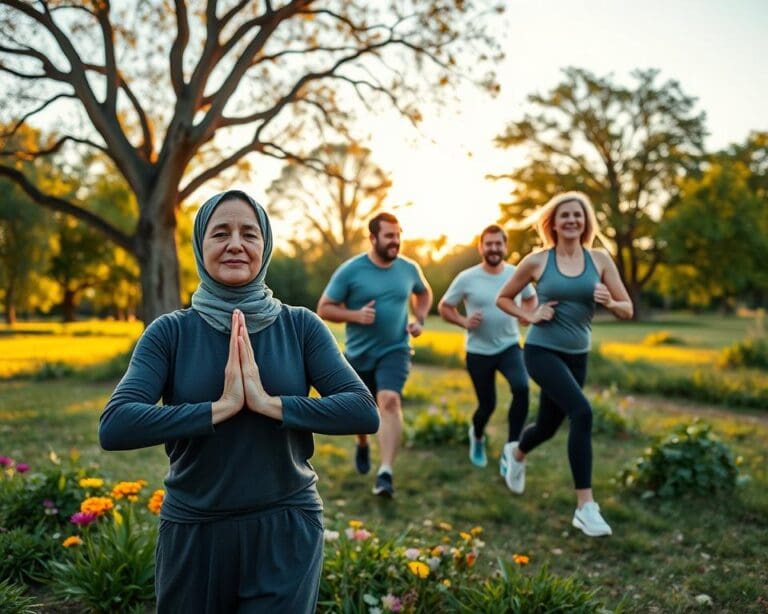An active lifestyle is a vital component of overall wellbeing, representing a commitment to incorporating regular physical activity into daily life. This approach encompasses a variety of movements, from intentional exercise and sports participation to engaging in everyday household chores. According to the World Health Organization, adults are encouraged to attain at least 150 minutes of moderate-intensity aerobic activity each week, complemented by muscle-strengthening activities on two or more days. What is considered an active lifestyle may differ greatly among individuals, influenced by personal health, age, and physical activity level. Embracing an active lifestyle not only enriches daily life but also unlocks numerous health benefits that can enhance both longevity and quality of life.
Understanding Active Lifestyles
Defining an active lifestyle goes beyond merely engaging in structured exercise. It encompasses a variety of movements and activities that encourage physical engagement throughout the day. Walking to your destination, cycling around the neighbourhood, participating in recreational sports, or attending gym sessions all contribute to this dynamic concept. Realising the impact of daily movement is essential for those aiming for improved health and well-being.
Defining an Active Lifestyle
When considering what it means to embrace an active lifestyle, it’s vital to recognise the range of activities involved. Incorporating regular movement into everyday routines plays a crucial role in fostering a healthier life. Activities such as dancing, gardening, and even playing with children can significantly increase your physical activity level. Each small effort counts, leading to greater rewards over time and showcasing the numerous benefits of staying active.
Physical Activity Levels Explained
The Centre for Disease Control and Prevention provides a framework to better understand various physical activity levels. These categories include:
- Sedentary: Minimal or no physical activity, often characterised by a lifestyle that involves prolonged periods of sitting.
- Lightly Active: Involves light everyday movements, like walking during errands or engaging in light housework.
- Moderately Active: Consists of regular exercise routines that elevate heart rate and respiration, such as brisk walking or cycling.
- Very Active: Encompasses vigorous activities that significantly challenge the body, including running or competitive sports.
Understanding these levels allows individuals to evaluate their current routine and strive for improvements. Participating in any category can provide substantial benefits of staying active, from decreasing the risk of chronic diseases to enhancing mood and contributing to longevity.

What Is Considered An Active Lifestyle
To understand what constitutes an active lifestyle, one must explore the recommended guidelines and practices that encourage regular physical activity. Understanding how to effectively measure activity can transform the way individuals approach their fitness journey. Recognising the importance of physical movement contributes significantly to overall well-being.
Measuring Activity: Guidelines and Recommendations
Engaging in an active lifestyle involves adhering to certain guidelines for an active lifestyle. According to the National Health Service (NHS), adults should aim for a minimum of 150 minutes of moderate aerobic activity each week. This benchmark serves as a solid foundation for anyone looking to enhance their physical fitness.
Alongside understanding these recommendations, utilising tools for measuring activity can provide valuable insights. Popular options include pedometers and smartphone applications that track movement and activity levels throughout the day. Such tools empower individuals to monitor progress and adjust goals as needed.
Implementing small lifestyle changes can further support efforts. Simple tips for staying active include opting for stairs instead of lifts and walking for short errands rather than driving. These manageable modifications can make a significant difference in achieving the recommended activity levels, paving the way for a healthier lifestyle.
Benefits of Staying Active
Staying active is a vital aspect of a healthy lifestyle. The array of benefits that come from embracing an active routine extends beyond mere visual appeal. People who engage in regular exercise often experience significant physical health benefits, including a decreased risk of chronic illnesses. The allure of becoming healthier is further complemented by the heartening effects of physical activity on one’s mental wellness and emotional benefits.
Physical Health Benefits
Regular participation in physical activities can lead to improved cardiovascular health, greater muscle strength, and increased flexibility. Engaging in consistent exercise serves as a formidable defence against diseases such as diabetes, heart disorders, and obesity. Incorporating movement into daily routines can transform an individual’s overall health and encourage longevity.
Mental Wellness and Emotional Benefits
The importance of regular exercise cannot be overstated when considering its impact on mental wellness. Activities that raise the heart rate stimulate the release of endorphins, which are crucial for fostering a positive outlook on life. Benefits such as reduced anxiety, lower stress levels, and enhanced cognitive function are notable advantages of staying active. Physical movement not only aids in boosting mood but also elevates overall emotional well-being.
Importance of Regular Exercise
The importance of regular exercise reaches far beyond just physical appearance. Making time for consistent physical activity yields significant benefits that enhance overall health and well-being. Committing to an active lifestyle serves as a powerful tool for improving both physical and mental health.
How Exercise Impacts Overall Health
Regular exercise plays a crucial role in weight management and the prevention of chronic diseases. Numerous studies reveal positive health impacts of exercise on cardiovascular health, muscle development, and even mental clarity. Physical activity stimulates various body systems and enhances the immune response, improving resilience against illnesses.
The Role of Consistency in Fitness
Consistency in fitness shapes the path towards reaping the benefits of an active lifestyle. Developing a routine of regular exercise fosters a habit that is essential for long-term success. Setting specific, achievable goals aids the journey, ensuring motivation remains high while gradually increasing intensity. Emphasising a disciplined approach not only leads to better results but reinforces the idea that fitness is a lifelong commitment.
Ways to Incorporate More Movement
In today’s fast-paced world, finding ways to incorporate more movement into daily life can significantly improve overall health and well-being. Rather than focusing solely on structured workouts, integrating physical activity into everyday activities offers a practical and enjoyable approach to being active. Small changes can yield substantial benefits, creating a more active lifestyle without overwhelming schedules.
Everyday Activities that Count
Engaging in everyday activities provides excellent opportunities for movement. Here are some simple yet effective ideas:
- Walking or cycling instead of driving for short trips.
- Taking the stairs instead of the lift.
- Gardening or tending to outdoor spaces.
- Joining a local sports team or fitness group.
- Playing with children or pets outdoors.
Each of these activities contributes to overall physical activity levels, allowing individuals to enjoy movement in a natural and fun way.
Setting Achievable Goals for Daily Activity
Establishing achievable goals can provide crucial motivation for incorporating more movement. Consider the following strategies:
- Start with a goal of walking 10,000 steps a day and gradually increase this number.
- Dedicating 30 minutes to a favourite activity, such as dancing or hiking, several times a week.
- Set reminders to stand up and stretch every hour during the workday.
By breaking down larger objectives into smaller, manageable steps, incorporating more movement becomes a pleasurable part of everyday routines.
Staying Active During Lockdown
The COVID-19 pandemic turned our lives upside down, challenging individuals to find new solutions for staying active during lockdown. With gyms closing and restrictions limiting outdoor activities, many people had to rethink their fitness routines and discover innovative ways to maintain their physical health. Online platforms surged in popularity, offering a plethora of virtual workout classes that catered to diverse fitness levels, allowing individuals to engage in everything from yoga to high-intensity interval training from the comfort of their living rooms.
Outdoor activities also saw a revival, with running, cycling, and brisk walks replacing the usual gym sessions. Communities came together, sharing tips for staying active and creating challenges that encouraged safe and responsible outdoor exercise. This collective spirit not only fostered physical well-being but also provided much-needed social interaction during isolation, reminding us of the importance of community in our fitness journeys.
It became increasingly clear that staying active during lockdown had profound psychological benefits, as movement serves as a natural mood enhancer. Maintaining a routine of physical activity proved essential for not just physical health, but also mental stability during these challenging times. The resilience and creativity displayed by individuals in finding ways to stay active remind us of our inherent ability to adapt and thrive, no matter the circumstances.









